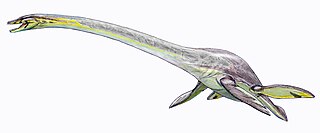
Plesiosauroidea is an extinct clade of carnivorous marine reptiles. They have the snake-like longest neck to body ratio of any reptile. Plesiosauroids are known from the Jurassic and Cretaceous periods. After their discovery, some plesiosauroids were said to have resembled "a snake threaded through the shell of a turtle", although they had no shell.

The Moeraki Boulders are unusually large and spherical boulders lying along a stretch of Koekohe Beach on the wave-cut Otago coast of New Zealand between Moeraki and Hampden. They occur scattered either as isolated or clusters of boulders within a stretch of beach where they have been protected in a scientific reserve. The erosion by wave action of mudstone, comprising local bedrock and landslides, frequently exposes embedded isolated boulders. These boulders are grey-colored septarian concretions, which have been exhumed from the mudstone enclosing them and concentrated on the beach by coastal erosion.

The South Polar region of the Cretaceous comprised the continent of East Gondwana–modern day Australia and Antarctica–a product of the break-up of Gondwana. The southern region, during this time, was much warmer than it is today, ranging from perhaps 4–8 °C (39–46 °F) in the latest Cretaceous Maastrichtian in what is now southeastern Australia. This prevented permanent ice sheets from developing and fostered polar forests, which were largely dominated by conifers, cycads, and ferns, and relied on a temperate climate and heavy rainfall. Major fossil-bearing geological formations that record this area are: the Santa Marta and Sobral Formations of Seymour Island off the Antarctic Peninsula; the Snow Hill Island, Lopez de Bertodano, and the Hidden Lake Formations on James Ross Island also off the Antarctic Peninsula; and the Eumeralla and Wonthaggi Formations in Australia.

The Plesiosauria or plesiosaurs are an order or clade of extinct Mesozoic marine reptiles, belonging to the Sauropterygia.

Plesiopleurodon is an extinct genus of Mesozoic marine reptiles, belonging to Sauropterygia, known from the Late Cretaceous of North America. It was named by Kenneth Carpenter based on a complete skull with a mandible, cervical vertebra, and a coracoid. In naming the specimen, Carpenter noted "Of all known pliosaurs, Plesiopleurodon wellesi most closely resembles Liopleurodon ferox from the Oxfordian of Europe, hence the generic reference." It was initially described as a pliosaur due to it short neck, a common trait of the family, although it is in the order Plesiosauria. However, later exploration into the relationships of both orders indicate that not all pliosaurs have short necks and not all plesiosaurs have long necks.

Mauisaurus is a genus of plesiosaur that lived during the Late Cretaceous period around 77 million years ago in what is now New Zealand. It was the largest plesiosaur, and perhaps the largest marine reptile in New Zealand waters at the time. Numerous specimens have been attributed to this genus in the past, but a 2017 paper restricts Mauisaurus to the lectotype and declares it dubious.
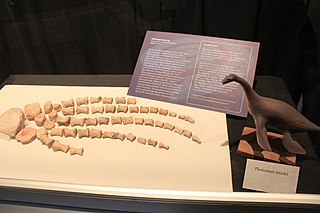
Woolungasaurus is a plesiosaur, an extinct marine reptile, belonging to the Elasmosauridae.
Shag Point, also known by its Māori name Matakaea, is a headland and township in East Otago, New Zealand.

Aristonectes is an extinct genus of plesiosaur from the Late Cretaceous Paso del Sapo Formation of what is now Argentina, the Quiriquina Formation of Chile and the Lopez de Bertodano Formation of Antarctica. The type species is Aristonectes parvidens, first named by Cabrera in 1941.
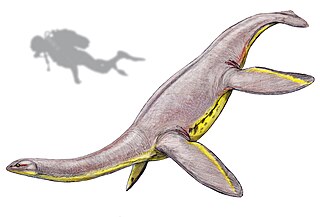
Kaiwhekea is an extinct genus of plesiosaur from the Late Cretaceous of what is now New Zealand.
Simocetus is an extinct genus of toothed whale that lived during the Oligocene period, approximately 32 million years ago, making it the oldest named toothed whale, although older unnamed toothed whales exist.
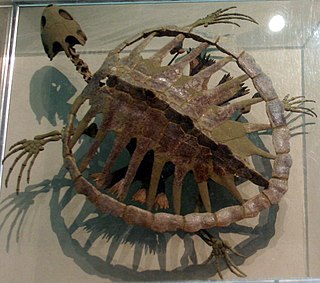
The Smoky Hill Chalk Member of the Niobrara Chalk formation is a Cretaceous conservation Lagerstätte, or fossil rich geological formation, known primarily for its exceptionally well-preserved marine reptiles. Named for the Smoky Hill River, the Smoky Hill Chalk Member is the uppermost of the two structural units of the Niobrara Chalk. It is underlain by the Fort Hays Limestone Member; and the Pierre Shale overlies the Smoky Hill Chalk. The Smoky Hill Chalk outcrops in parts of northwest Kansas, its most famous localities for fossils, and in southeastern Nebraska. Large well-known fossils excavated from the Smoky Hill Chalk include marine reptiles such as plesiosaurs, large bony fish such as Xiphactinus, mosasaurs, flying reptiles or pterosaurs, flightless marine birds such as Hesperornis, and turtles. Many of the most well-known specimens of the marine reptiles were collected by dinosaur hunter Charles H. Sternberg and his son George. The son collected a unique fossil of the giant bony fish Xiphactinus audax with the skeleton of another bony fish, Gillicus arcuatus inside the larger one. Another excellent skeleton of Xiphactinus audax was collected by Edward Drinker Cope during the late nineteenth century heyday of American paleontology and its Bone Wars.
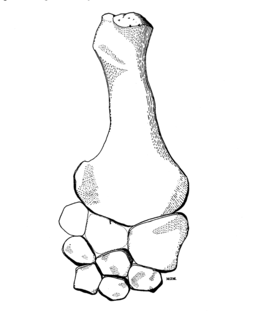
Tatenectes is a genus of cryptoclidid plesiosaur known from the Upper Jurassic of Wyoming. Its remains were recovered from the Redwater Shale Member of the Sundance Formation, and initially described as a new species of Cimoliosaurus by Wilbur C. Knight in 1900. It was reassigned to Tricleidus by Maurice G. Mehl in 1912 before being given its own genus by O'Keefe and Wahl in 2003. Tatenectes laramiensis is the type and only species of Tatenectes. While the original specimen was lost, subsequent discoveries have revealed that Tatenectes was a very unusual plesiosaur. Its torso had a flattened, boxy cross-section and its gastralia exhibit pachyostosis (thickening). The total length of Tatenectes has been estimated at 2–3 meters (6.6–9.8 ft).
Alexandronectes is a genus of elasmosaurid plesiosaur, a type of long-necked marine reptile, that lived in the oceans of Late Cretaceous New Zealand. It contains one species, A. zealandiensis. Fossils of Alexandronectes were found in the Conway Formation of Canterbury.
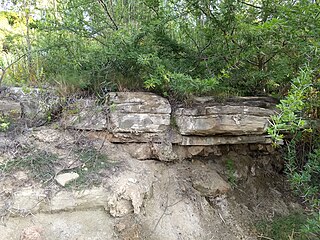
The Sundays River Formation is a geological formation found in the Eastern and Western Cape provinces in South Africa. It is the second youngest of the four formations found within the Uitenhage Group of the Algoa Basin, its type locality, and the only location where outcrops have been located. The Sundays River has been measured at a maximum thickness of 2,000 metres (6,600 ft).

The Tahora Formation is a Late Cretaceous geologic formation that outcrops in northeastern New Zealand near Gisborne. It is Haumurian in age according to the New Zealand geologic time scale. It forms part of the Upper Cretaceous to Teurian (Danian) Tinui Group. It unconformably overlies the Jurassic to Lower Cretaceous Urewera Group or the Upper Cretaceous Matawai Group. It is conformably overlain by the Haumurian to Teurian Whangai Formation. It consist of three members, the Maungataniwha Sandstone Member, the Mutuera Member and the Houpapa Member. It is named for Tahora Station, south of Matawai in the Gisborne Region. The aptly named Maungataniwha Sandstone Member is known for its rich reptile fossil remains, first investigated by amateur palaeontologist Joan Wiffen.

The Conway Formation is a Campanian to Danian geologic formation in the South Island of New Zealand and therefore crosses the Cretaceous–Paleogene boundary. Plesiosaur remains are among the fossils that have been recovered from its strata. The Conway Formation is part of the Eyre Group and Haerenga Supergroup.

This timeline of plesiosaur research is a chronologically ordered list of important fossil discoveries, controversies of interpretation, taxonomic revisions, and cultural portrayals of plesiosaurs, an order of marine reptiles that flourished during the Mesozoic Era. The first scientifically documented plesiosaur fossils were discovered during the early 19th century by Mary Anning. Plesiosaurs were actually discovered and described before dinosaurs. They were also among the first animals to be featured in artistic reconstructions of the ancient world, and therefore among the earliest prehistoric creatures to attract the attention of the lay public. Plesiosaurs were originally thought to be a kind of primitive transitional form between marine life and terrestrial reptiles. However, now plesiosaurs are recognized as highly derived marine reptiles descended from terrestrial ancestors.
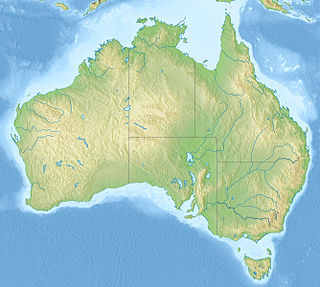
The Bulldog Shale is a formation of Early Cretaceous age that forms part of the Marree Subgroup of the Rolling Downs Group, located in the Eromanga Basin of South Australia, Queensland and New South Wales.















